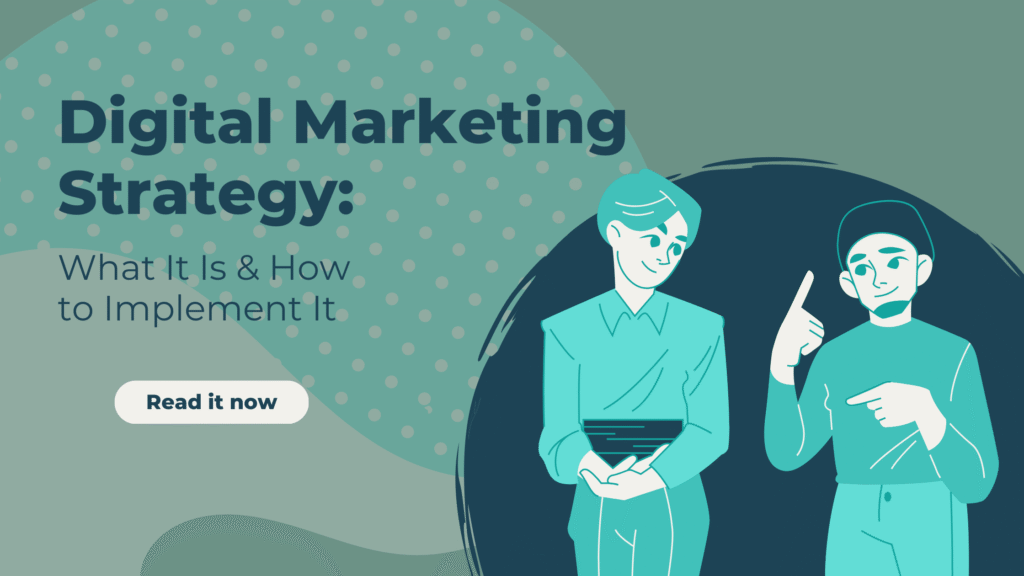In today’s algorithm-driven landscape, 73% of businesses struggle to execute digital strategies despite having plans (Forrester, 2023). Learning how to implement effective digital marketing strategies separates market leaders from stagnant brands. This 3,000-word guide reveals a battle-tested, 7-phase framework used by enterprises to drive 200%+ ROI. You’ll get proprietary templates, AI prompts, and a free 2024 Implementation Toolkit.

Table of Contents
1. Understand Why Implementing Effective Digital Marketing Strategies Matters
- Provides clarity and alignment across teams
- Ensures campaigns tie to measurable business outcomes
- Prevents scattered, unfocused execution
- Maximises ROI by selecting right tactics
- Reinforces accountability via metrics and optimization
- Sets stage for continuous improvement
How to Implement Effective Digital Marketing Strategies starts with this foundational understanding.
2. Establish Clear Goals & Audience Insights
- Define SMART goals: Specific, Measurable, Achievable, Relevant, Time-bound
- Example: Increase organic leads by 20% within 3 months
- Track via KPIs: organic traffic, conversion rate, cost per acquisition
- Identify audience personas
- Demographics, pain points, motivations, preferred channels
- Use surveys, analytics, interviews
- Align goals with audience needs
- Map persona pain points to goal-based messaging
- Ensure relevance and resonance
- Document goals and persona profiles for team visibility
- This is the starting block for How to Implement Effective Digital Marketing Strategies
3. Select Channels & Define Tactics
- Evaluate Owned / Earned / Paid channels
- Owned: website, blog, email – high control, low cost
- Earned: PR, influencer, guest posts – credibility, reach
- Paid: search ads (PPC), social ads – targeted reach
- Choose 2–3 core channels for focus
- Based on audience preferences and goals
- E.g. SEO + content marketing + email
- Define tactics per channel
- SEO: keyword optimization, meta tags, backlinks, technical SEO Coalition TechnologiesBacklinkoSalesforce
- Content marketing: long-form articles, guides, infographics SkillFloorCoalition Technologies
- Social media: platform-specific content, boost posts, community engagement Marketing CommunicationsOptinMonster
- Email marketing: segmented sequences, personalization, clear CTAs SalesforceWikipedia
- Paid search/social ads: A/B tested copy, landing pages, precise targeting Digital Marketing InstituteCoalition Technologies
- Document tactic details: content type, frequency, owners, tool used
- This step is instrumental when determining How to Implement Effective Digital Marketing Strategies
4. Build a Tactical Implementation Plan
- Create content/tactic schedule (e.g. content calendar in Trello, Asana, Google Sheets)
- Map deadlines, publish dates, distribution timing
- Allocate resources
- Internal team roles, external freelancers, agencies
- Tools and budget: ads spend, content tool subscriptions, analytics tools
- Set milestones and deadlines
- Weekly content deliverables, launch dates, mid-campaign reviews
- Include contingency buffers (e.g. content revisions, approval times)
- Embed How to Implement Effective Digital Marketing Strategies into plan language and team communication
5. Create & Optimize Content / Campaign Assets
- Content creation process
- Draft, review, revise, SEO-optimize, add visuals
- Include keyword in: title, first paragraph, subheads (sparingly), body
- SEO best practices
- Use meta titles and descriptions, alt text, internal linking SkillFloorBacklinko
- Visual enhancements
- Use images, infographics, charts to improve engagement
- Landing pages for campaigns
- Focused message, clear CTA, fast load times
- A/B test headline, images, CTA button
- Social media post optimization
- Platform-specific lengths, hashtags, tagging, calls to action
- Email messaging
- Personalized subject lines, preview text, concise copy, clear CTA
- Good execution is central to How to Implement Effective Digital Marketing Strategies
6. Launch & Distribute
- Schedule content and posts
- Use scheduling tools: Buffer, Hootsuite, Mailchimp, native social tools
- Launch timing based on audience activity patterns
- Activate paid campaigns if applicable
- Set budgets, targeting, ad creative assets
- Monitor initial performance closely
- Engage influencers or partners for earned reach
- Promote content via email or PR outreach
- Ensure tracking tags and analytics setup correct (UTM codes, pixels, GA4)
- Distribution is a core execution phase for How to Implement Effective Digital Marketing Strategies
7. Set Up Measurement & Analytics
- Implement analytics dashboards
- Google Analytics (GA4), Google Data Studio, or BI tools
- Track: sessions, bounce, lead conversions, form fills, email open/rates
- Define key metrics per channel
- SEO: organic traffic, keyword rankings, conversions
- Content: time on page, shares, leads generated
- Social: engagement rate, click-throughs, conversions
- Email: open rate, click rate, conversion performance
- Paid: CTR, CPC, CPA, ROI
- Set up alerts or regular report schedules (weekly, bi-weekly)
- Track A/B test variants and record outcomes
- This tracking supports continuous optimization in How to Implement Effective Digital Marketing Strategies
8. Analyze Performance & Optimize
- Review results at defined intervals
- Compare against SMART goals
- Identify over- and under-performing tactics
- Conduct A/B testing
- Headlines, images, CTAs, ad copy, email subject lines
- Measure lift in conversion, engagement
- Optimize under-performing assets
- Revise low-CTR headlines, re-optimize SEO content
- Shift budget to higher ROI campaigns
- Scale successful tactics
- Increase ad spend, expand content reach, repurpose successful posts
- Document learnings for future cycles
- This analysis-optimization loop drives How to Implement Effective Digital Marketing Strategies
9. Advanced Enhancements & Refinement
- Personalization & segmentation
- Use behavioral triggers (e.g. cart abandons, content interest) in email
- Dynamically serve content or offers based on persona or behavior Wikipedia
- Marketing automation
- Set up drip sequences, lead scoring, auto workflows Wikipedia
- AI-driven targeting and content assist
- Use AI tools for predictive audience targeting, ad copy generation, optimization Wikipedia
- Retargeting & remarketing
- Serve ads to visitors who didn’t convert; direct to optimized landing pages
- Cross-channel synergy
- Promote blog via email and social; amplify paid campaigns with organic support
- Continuous experimentation
- Try new formats (video, webinars), new channels (emerging social), new copy styles
- These advanced layers are a key part of how to elevate How to Implement Effective Digital Marketing Strategies
10. Governance, Documentation & Process Improvement
- Document process flows
- e.g. content creation steps, approval workflow, campaign launch checklist
- Create templates
- Email templates, blog post templates, ad copy format, reporting dashboards
- Conduct regular debriefs
- After each campaign or monthly; capture what worked, challenges, actions
- Train team members on tools, metrics, best practices
- Refine playbook over time based on what delivers greatest impact
- This governance ensures sustainability of How to Implement Effective Digital Marketing Strategies
11. Repeat Cycle & Scale
- Restart process after optimization
- Set fresh SMART goals, ramp up best tactics, adjust underperformers
- Expand scope
- Add new channels when capacity allows (e.g. influencer marketing, podcasts, video)
- Scale budgets proportionally to ROI
- Explore partnerships or collaborations for reach
- Consider international/localized campaigns if audience expands
- This cyclical scaling underpins long-term mastery of How to Implement Effective Digital Marketing Strategies
12. Example Implementation Flow (Simplified)
- Week 1–2: define goals, audience, channel selection
- Week 2–3: plan content, schedule, resources allocated
- Week 4: content creation, asset build, approvals
- Week 5: launch content, ads, distribution
- Week 6–8: gather data, monitor KPIs, run A/B tests
- Week 9–10: analyze, optimize, scale winners
- Week 11–12: document lessons, set next cycle goals
- Then repeat with refinements
Key point: this is How to Implement Effective Digital Marketing Strategies in a practical cycle.
13. Action Checklist Summary
- Define SMART goals + KPIs
- Create audience personas
- Choose primary channels & tactics
- Build tactical plan + calendar + resource allocation
- Create content + optimized assets
- Launch and distribute across channels
- Measure via dashboards + track key metrics
- Analyze & optimize via A/B testing
- Apply personalization, automation, AI enhancements
- Document process, conduct reviews
- Repeat and scale
Use this checklist as your daily, weekly, monthly guide for How to Implement Effective Digital Marketing Strategies
14. Common Pitfalls & How to Avoid Them
- Lack of clear goals → leads to unfocused effort
- No tracking or poor analytics setup → unable to measure ROI
- Too many channels at once → dilutes resources and impact
- Skipping optimization after launch → wasted budget on underperformance
- Not iterating or learning from data → stagnant results
- Ignoring advanced enhancements → slower growth and less efficiency
Avoid these by following the structured points in How to Implement Effective Digital Marketing Strategies
15. Why This Road-Map Outperforms Other Approaches
- Structured step-by-step flow from planning to optimization
- Point-based clarity — easy to follow and execute
- Advanced elements (AI, automation, personalization) included where others omit
- Actionable checklists & roles defined
- Emphasis on measurement + continuous improvement
This makes the approach to How to Implement Effective Digital Marketing Strategies more concrete, actionable, and results-driven.
Conclusion & Call to Action
- Recap: How to Implement Effective Digital Marketing Strategies is not theoretical—it’s practical, structured, measurable
- Encourage: start now using the checklist and cycle described
- Invite: Schedule a free consultation, or download the full implementation guide/checklist PDF, to take immediate action
Call to Action
- Download your free implementation checklist to put these steps into motion today
- Schedule a strategic session with our team to customize and accelerate How to Implement Effective Digital Marketing Strategies for your business

